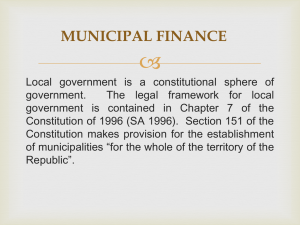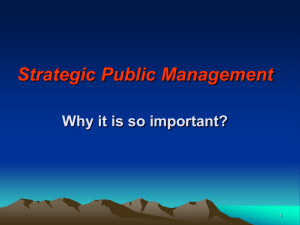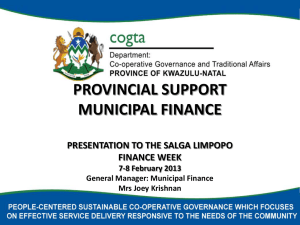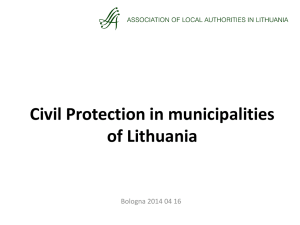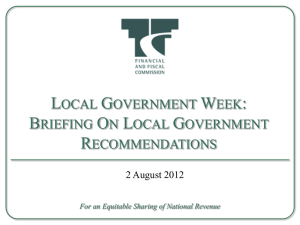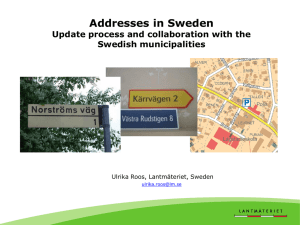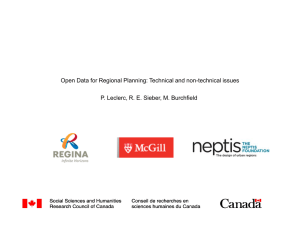Broadening effective oversight to impact the
advertisement
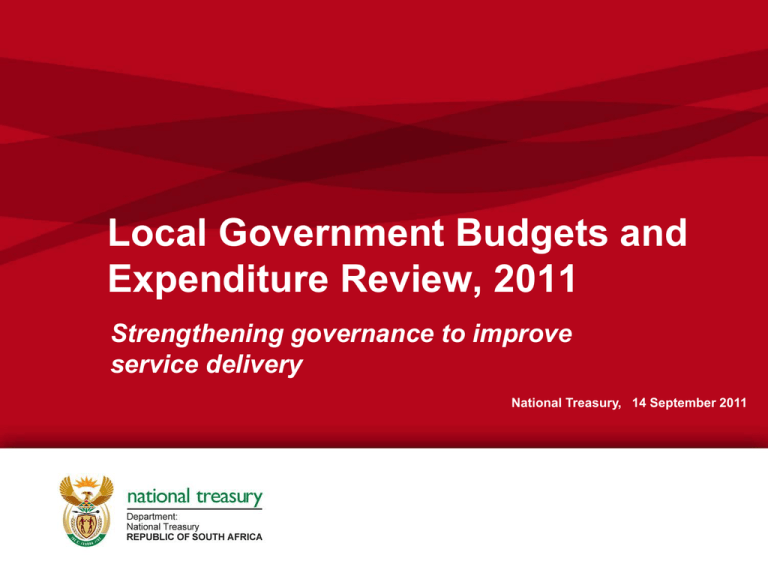
Local Government Budgets and Expenditure Review, 2011 Strengthening governance to improve service delivery National Treasury, 14 September 2011 Why a Local Government Budgets and Expenditure Review? Review measures progress in local government Review shows where municipalities have allocated and spent public money Review explores developmental role of municipalities Review shows link between policies, budgets, expenditures and outputs • Allows progress over the last three years to be measured • Are municipalities delivering services to all? • Are municipal budgets allocating funds in line with development priorities? • Are budgets buying the planned outputs? • Does government need to adopt a more differentiated approach to enable rural and urban municipalities to be more effective? • Are policies delivering the intended outcomes? 2 Data issues Factors that impact on the comparability of information over the period Every effort made to ensure reliability of budget and expenditure information Detailed budget and expenditure data published on National Treasury’s website • The implementation of the Municipal Budget And Reporting Regulations • Compliance with the MFMA requirement relating to consolidated budgets and financial statements • Replacement of the RSC levy for metros has an impact on the local government equitable share • The following sources were used: • Audited financial statements for 2006/07 to 2008/09 • Available audited financial statements and pre-audit information for 2009/10 • Budget and related documents for 2010/11 to 2012/13 • www.treasury.gov.za/publications/igfr/2011/default.aspx 3 Outline of presentation Key findings of the review Summary of chapters Conclusion 4 Local government faces ongoing challenges Demographic pressures arising from urbanisation Economic pressures arising from economic growth Crisis in credibility Percentage of population in urban areas and growth in urban population Gross value added per capita by type of municipality, 2009 Trust in government institutions, 2004 to 2009 80% 60000 70% Rand per capita 50000 40000 60% 30000 50% 20000 40% 10000 30% 0 20% Metros Secondary cities Large towns Small towns Mostly rural 10% 1 Agriculture 2 Mining 3 Manufacturing 4 Electricity 5 Construction 6 Trade 7 Transport 8 Finance 9 Community services 0% National Government 2004 Provincial Government 2005 2006 2007 2008 Local Government 2009 5 There is considerable pressure for infrastructure investment and improved service delivery Households without access to basic services, 2007 4.0 40% 3.5 Households (millions) 35% Percentage of population To combat poverty Proxies of poverty by municipal location, 2007 30% 25% 20% 15% 3.0 2.5 2.0 1.5 10% 1.0 5% 0.5 0.0 0% Metros Secondary cities Large tow ns Receiving social grants Small tow ns Refuse Mostly rural Unemployed (official definition) Metros Sanitation Water Secondary cities Large tow ns Electricity for lighting Small tow ns Formal housing Mostly rural 100 60 Rands billion To support growth 80 40 20 0 Dec 98 Dec 99 Dec 00 Dec 01 Total passed Dec 02 Dec 03 Dec 04 Dec 05 Total LG capex Dec 06 Dec 07 Dec 08 Dec 09 Nominal value of building plans passed and completed vs local government capital expenditure, 1998 – 2009 Total completed 6 National government continues to provide significant support to local government Massive real growth in national transfers Transfers by type, 2006/07 2012/13 Significant policy reforms • Municipal Budget and Reporting Regulations • Three-year allocations and payment schedules for national and provincial transfers (DoR Act) • Improved in-year financial monitoring Targeted capacity and systems support • Support in planning and budget reform • R3bn spent on Siyenza Manje between 2007 and 2010 to provide hands-on support to municipalities • Additional support through conditional grants 7 … and municipal challenges remain … Priorities Limited focus on economic development Inadequate spending on repairs and maintenance Prevalence of nonpriority spending Policies and plans Outdated spatial plans Poor quality IDPs Unfunded budgets Procedures Poor revenue management Badly managed procurement processes Poor asset management processes Performance Delays in approving development plans Underspending of capital budgets Deteriorating levels of service 8 The 2011 LGBER offers both new and updated analysis of key issues Focuses on the adequacy of municipal initiatives Structured in four parts • Supporting economic growth • Providing basic services and supporting development • Strengthening governance and the stewardship of resources • Social and economic context for local governance • Financing and management issues: trends, MFMA implementation, leveraging private finance and municipal personnel management • Service delivery: water and sanitation, electricity, roads and solid waste services • Service delivery contexts: delivering services in rural areas, and managing cities 9 Key issues identified… Quality of governance is critical to performance • Governance challenges undermines service delivery • More competent senior mangers needed • Instability in senior management detracts from continuity • • • • • Depleted cash reserves – operating at the absolute margin General under-pricing of municipal services – bankrupting municipalities Revenue projections are unrealistic – not based on requirements of the MFMA Operating expenditures are too high – driven by non-priority spending Capital budgets are too ambitious Maintenance of existing assets needs urgent attention • • • • Lack of key technical skills – qualified managers, engineers and technicians Weak asset management systems Spending on repairs and maintenance inadequate to maintain assets Maintenance spending is reactive, and so is more costly than planned maintenance Own funding of capital budgets needs to increase • Increased grant reliance, and reduced own funding of the capital budget • Tariffs and operating budgets not making provision to fund capital • Municipalities (other than metros) not adequately leveraging private finance to fund economic infrastructure Reconceptualise approach to combat poverty • New housing developments are located on the periphery far from economic opportunities and services • Municipalities are not using labour intensive approaches to deliver services • Current modes of service delivery are too expensive and unsustainable, especially for poor households in rural areas Municipal budgets must be funded and realistic 10 Potential policy responses include … Focus on leadership • • • • Bring mayors and councils into the Outcomes monitoring system Depoliticise senior management appointments Appoint competent MMs, CFOs and senior managers Highlight difference between political leadership and management roles Creating fiscal space • • • • • Get back to basics in all aspects of revenue management and cash management Ensure tariffs are cost-reflective – including maintenance and capital spending Make more innovative use of opportunities to leverage private finance Ensure value-for-money in procurement and contract management Eliminate non-priority spending Focussing on sustainable human settlements • Use spatial planning, development approval and location of bulk infrastructure to guide private investment decisions • Effective development control to ensure poor households are located close to economic opportunities • Ensure co-ordination of infrastructure and housing investments Ensuring fiscally sustainable choices in service delivery • • • • Adopting a differentiated approach towards municipalities Increase funding for repairs and maintenance Ensure indigents policy is appropriately structured and properly implemented Use appropriate service standards and technologies, especially in rural areas Use labour intensive service delivery methods • Better coordination of financing with the allocation of powers and functions • Devolving of functions to municipalities with management capacity, especially housing and transport • Structuring the local government fiscal framework around municipalities’ fiscal capacity, to ensure more equitable funding of rural municipalities • Targeting support to municipalities where assistance is needed and there is a willingness to co-operate 11 Outline of presentation Key findings of the review Summary of chapters Conclusion 12 Summary of chapters Introduction and context • 1. Introduction • 2. Socio-economic and fiscal context of local government • 3. Intergovernmental relations and the local government fiscal framework Financial issues • • • • 4. 5. 6. 7. Service delivery • • • • 8. Water and sanitation 9. Electricity 10. Roads 11. Solid waste services Delivery contexts of rural and city municipalities Revenue and expenditure trends in local government Financial management and MFMA implementation Leveraging private finance Managing municipal personnel • 12. Delivering municipal services in rural areas • 13. Cities and the management of the built environment 13 There are significant differences between municipalities Average household size by type of municipality, 2001 and 2007 8 Demographic trends Average household size 7 6 5 4 The Census in October 2011 is critical to updating this information 3 2 1 0 Metros Census 2001 Secondary cities Community Survey 2007 Large tow ns Small tow ns Smallest in category 2007 Largely rural Largest in category 2007 Share of economic sector by type of municipality, 2009 100% 60% 40% 20% Secondary cities Small towns Mostly rural Large towns 8 Finance 9 Community services Metros 7 Transport 6 Trade 5 Construction 4 Electricity 3 Manufacturing 2 Mining 0% 1 Agriculture Economic profiles Percentage 80% 14 Chapter 2 Socio-economic and fiscal context of local government This requires municipalities to respond differently to their specific contexts Proxies of poverty by type of municipality, 2007 40% Combating poverty Percentage of population 35% 30% 25% 20% 15% 10% 5% 0% Metros Secondary cities Large tow ns Receiving social grants Small tow ns Mostly rural Unemployed (of f icial def inition) Growth by economic sector, 2006 and 2009 6.0% Percentage 4.0% Supporting economic growth All municipalities need to be aware of the poverty and unemployment within their jurisdictions, so they develop appropriate service delivery strategies, indigent policies and revenue strategies. 2.0% 0.0% -2.0% -4.0% -6.0% Growth 2006-07 Growth 2007-08 Growth 2008-09 Municipalities need to be aware of how the sectors of the economy represented within their areas are performing – and then tailor their spatial plans and IDPs to provide appropriate support 15 Chapter 2 Socio-economic and fiscal context of local government … while also responding to the opportunities created by national fiscal policy Transfers to local government, 2006/07 – 2012/13 80000 70000 Growth in transfers to local government Rand million 60000 50000 40000 30000 20000 10000 0 2006/07 2007/08 Equitable share Conditional grants 2008/09 2009/10 2010/11 2011/12 2012/13 Transfers to LG grow by 10.4% between 2010/11 and 2013/14, compared to 7.6% for total government spending Fuel levy sharing with metros Indirect transfers Stable macroeconomic policy • Insulating LG from the effects of the recession • Stable and transparent transfers to LG • Prudent fiscal stance provides room for increased borrowing by municipalities Public investments • Expanded public investment in infrastructure places pressure on municipal development planning and approval processes 16 Chapter 2 Socio-economic and fiscal context of local government …and learning to do things better Lessons from the World Cup • Success depends on hiring the best • Use ‘anchor management tools’ to drive delivery • Forward thinking in risk management of projects • Detailed cash management and payment transparency 120 111 105 Crisis in credibility Number of protest actions 100 80 60 40 20 34 32 27 10 2 0 2004 Getting governance right 2005 2006 2007 2008 2009 2010 Service delivery protests, 2004 to 2010 Disputes with ratepayers in 42 towns – paying funds into trust accounts • Commit to acting ethically and in the best interests of the municipality • Understand and respect the council/management division of responsibilities • Make appointments on the basis of competency • Put operating policies and procedures in place • Councils must fulfill their oversight function 17 Chapter 2 Socio-economic and fiscal context of local government Local government has very specific service delivery responsibilities • Section 152 of the Constitution Objects of local government • to provide democratic and accountable government for local communities • to ensure the provision of services to communities in a sustainable manner • to promote social and economic development • to promote a safe and healthy environment • to encourage the involvement of communities and community organisations in the matters of local government • Section 153 of the Constitution Developmental duties of municipalities Priority functions of municipalities • A municipality must • Structure and manage its administration and budgeting and planning processes to give priority to the basic needs of the community, and to promote the social and economic development of the community, and • Participate in national and provincial development programmes Water (potable) Electricity reticulation Sanitation Refuse removal Cemeteries Fire fighting Municipal health services Municipal planning Municipal roads Storm water Traffic and parking Building regulations Municipal public transport 18 Chapter 3 Intergovernmental relations and the local government fiscal framework That the WHOLE local government fiscal framework is designed to finance municipalities Transfers and Grants Municipal own revenues Direct transfers Operating revenues Equitable share & RSC levy replacement grant Rates and taxes Municipal operating budget National / provincial operating grants Service charges Sources of capital funding National / provincial infrastructure grants Indirect transfers Surplus / cashbacked reserves Municipal borrowing Municipal capital budget 19 Chapter 3 Intergovernmental relations and the local government fiscal framework At the heart of local government is managing finances to deliver services Assignment of functions Allowed taxes Priority of LG in vertical divisions Design of ES Formula Non-priority wants Policy constraints on fiscal potential Demand for other important services Conditional transfers Borrowing National and provincial mandates Demand for basic services Service charges Low tariffs Poor billing Poor debt management Theft and graft Revenue forgone Bad management Inefficient procurement Conditional transfers Borrowing Rates and taxes Service charge revenue Rates and taxes Institutional set up Community needs and wants Equitable share LG Fiscal Framework Under-spending Revenue lost due to lack of fiscal effort Equitable share Revenue choices and collection Non-priority wants “Leakages” Other important services Mandates Basic services Non-priority wants Effective and efficient expenditure Mandates Basic services Institutional set up Institutional set up Budgeted expenditure choices Other services Managing delivery 1 Actual service delivery 20 Summary of chapters Introduction and context • 1. Introduction • 2. Socio-economic and fiscal context of local government • 3. Intergovernmental relations and the local government fiscal framework Financial issues • • • • 4. 5. 6. 7. Service delivery • • • • 8. Water and sanitation 9. Electricity 10. Roads 11. Solid waste services Delivery contexts of rural and city municipalities Revenue and expenditure trends in local government Financial management and MFMA implementation Leveraging private finance Managing municipal personnel • 12. Delivering municipal services in rural areas • 13. Cities and the management of the built environment 21 Municipalities are important economic actors • LG expenditure averages about 6.9% of GDP Contribution to GDP • LG infrastructure and services are essential inputs to the rest of the economy • Approximately 80% of GDP generated in the 27 largest cities Contribution to infrastructure investment • LG responsible for 15.9% of total public sector infrastructure expenditure • Share is declining due to more rapid growth in capital expenditures by provinces and public enterprises 22 Chapter 4 Revenue and expenditure trends in local government They manage a significant portion of the public budget Significant component of total public expenditures • 20.0% of total government spending in 2009/10 Municipal own revenues are key to service delivery • The revenue –service link between customers and municipalities is an important dimension of democratic local accountability Significant variation between municipalities • R176.3 billion in operating revenues, mainly from service charges, property rates and grants • R37.5 billion in capital expenditure, funded mainly by grants • Revenues from service charges pay for bulk electricity and water • National transfers recognise differences in fiscal capacity and support the extending access to basic services • Average annual per capita spending of R4208 in 2009/10, but varies from R6609 in Gauteng to R1993 in Limpopo • Reflects variations in: • provision of services, no. of business customers and income levels • levels of revenue effort and capacity to spend • maturity, given history of local government in region 23 Chapter 4 Revenue and expenditure trends in local government Municipalities continue to face important fiscal challenges Municipal own contribution to capital spending Pay attention to revenue management Municipal own contribution to capital expenditure, 2006 to 2012 Municipal own contributions are now less than 50% of total capital spending • Get the basics right to ensure revenue value-chain is complete • Integrity of billing information, accuracy of billing systems and ability to collect High outstanding consumer debts • In December 2010, municipalities were owed a total of R62.3 billion. This represents an increase of 10.8% from the same month in 2009 Under-pricing of services • Municipalities not following the Systems Act principles for tariff setting • On average, tariffs must reflect the cost of rendering the service Inadequate spending on repairs and maintenance • Cutting spending on maintenance is not seen as politically sensitive, but will have a disastrous impact on the reliability of services 24 Chapter 4 Revenue and expenditure trends in local government MFMA aims to ensure alignment in the municipal accountability cycle Five-year strategy Planned future reforms IDP Three-year budget Budget SDBIP Annual implementation plan In-year reporting Implementation monitoring Annual Accountability reporting financial statements Annual report Oversight report Accuracy of • information • depends on: • Organisational structure aligned to basic services Sound municipal policies, processes and procedures Standard chart of accounts for municipalities Recent financial management reforms • Municipal Budget and Reporting Regulations • Strengthening in-year reporting • Return of unspent conditional grants to the national revenue fund in line with DoRA • Standard chart of accounts of local government • Strengthening revenue and cash management • Structure of the Service Delivery and Budget Implementation Plan • Strengthen reporting on non-financial information • Regulations on financial misconduct to facilitate enforcement 25 Chapter 5 Financial management and MFMA implementation Management is improving in response to financial management reform programme 120 Number of municipalities Reforms essential for accountability Improving audit outcomes, off a low base Audit opinions for all municipalities, 2006/072009/10 100 80 60 40 20 0 2006/07 2007/08 2008/09 2009/10 Disclaimer of opinion Qualified Unqualified - Emphasis of Matter Unqualified - No findings Audits Outstanding 19 11 9 7 104 110 88 53 73 63 48 50 54 91 109 120 1 4 4 7 32 4 25 46 80% 60% 40% 20% 0% Tabled on time Approved on time Improved reporting Municipalities that tabled and approved budgets on time, 2005/062010/11 100% Percentage Improved budgeting More timely budget preparation Adverse opinion 2005/06 47% 97% 2006/7 81% 94% 2007/8 86% 98% 2008/9 81% 91% 2009/10 89% 61% 2010/11 89% 82% • In-year reporting coverage has improved and all municipalities now report on a routine basis • Annual financial statements are submitted by most municipalities • More municipalities need to produce annual reports 26 Chapter 5 Financial management and MFMA implementation Concerns with the quality of budgeting… INDETERMINATE, 25% Many municipal budgets are not funded Need to strengthen capacity FUNDED, 43% UNFUNDED, 32% Funding compliance of municipalities’ approved 2010/11 budgets Only 123 municipalities had budgets that were adequately funded • Municipalities need to prepare for implementation of the Competency Regulations • Internship programme – 1241 interns have been through the programme since 2004 • National Treasury is now responsible for the deployment of hands-on financial support to municipalities 27 Chapter 5 Financial management and MFMA implementation Scope exists to improve access to private finance 300 Municipal infrastructure investment requirement, 2009 250 200 R billion Demand for capital infrastructure remains high Rehabilitating existing infrastructure is a priority 150 100 50 Metros and secondary cities Growth Town based municipalities Backlogs Mostly rural municipalities Rehabilitation Scope exists for • National transfers are the major source of finance for municipal capital budgets – they provided 51% of capital funding in 2010/11 further growth in private capital • External loans contributed 20.7% as a funding source in 2010/11. This is down from 24.9% in 2006/07. funding Lending dominated by the DBSA Trends in the municipal borrowing market INCA (a major private lender) has withdrawn from the municipal market 28 Chapter 6 Leveraging private finance Various sources of private finance are available Municipal borrowing Development charges Land based financing strategies Public Private Partnerships • Municipal borrowing increased from R18.7bn to R38.1bn between 2005 and 2010 (growth of 15% per annum) • Municipal bonds issued by Johannesburg, Cape Town and Ekurhuleni come to R11.8bn • Costs of new infrastructure are paid by the property owners benefiting from such developments • Facilitates more rapid development, and a better application of scarce capital funding • Using the proceeds from land sales to finance infrastructure replaces an appreciating asset with a depreciating asset • Good stewardship = using the proceeds from selling municipal land to buy other land • Alternatives – security for loans, leaseholds, land-use exchanges and land swaps • Aim to use municipal land to facilitate realisation of the municipality’s spatial development framework • A model for risk sharing between a municipality and its private sector partners • Private partners raise debt and equity to finance the project 29 Chapter 6 Leveraging private finance Scope exists to further develop private finance opportunities Clear regulatory framework in place Dealing with constraints • • • • National government does not stand surety National and provincial government may not lend to municipalities Municipalities may offer lenders a range of credit enhancements Term of borrowing may not exceed the useful life of the assets being financed • Municipalities are encouraged to get credit ratings • Forward planning of capital budgets is generally poor, resulting in underspending • Growth in conditional grants to fund capital are reducing municipalities’ incentive to explore alternative financing mechanisms for infrastructure • Need to develop the capacity of the treasury function • Explore creating a pooled finance vehicle for secondary cities • DBSA needs to find ways of crowding in private finance, rather than competing with private lenders 30 Chapter 6 Leveraging private finance Staff are a major municipal asset Significant number • Over 278 000 jobs, or 2.1% of total SA employment (2009) of employees • Accounts for between 25 and 30% of operating expenditures Expenditures growing faster than jobs • Personnel expenditure increases from R30bn in 2006/07 to R46.7bn in 2009/10 (growth of 52.5%) • Employment grew by 4% or 10 700 employees between 2006 and 2009 • Vacancies rose from 21.9% to 23.2% between 2006 and 2008, mainly due to municipalities revising their organisational structures 2006 2009 Category A (Metros) 122 033 230 777 47.1% Category B (Locals) 102 361 145 445 29.6% 142 069 160 439 11.4% Towns - 140 83 886 129 234 35.1% Mostly rural - 70 88 029 158 826 44.6% Category C (Districts) 137 005 202 438 32.3% Category B + C 106 130 152 940 30.6% Rand Cost per employee rising (mostly slower than wage increases) Secondary cities - 21 Percentage grow th Average cost per employee, 2006 and 2009 Wage agreements from 2006 to 2009 provide for a cumulative basic increase of 35.73% 31 Chapter 7 Managing Municipal Personnel Personnel policies require careful management 2009 Pos itions fille d Total pos itions Pe rce ntage pos itions vacant Num be r By cate gory of m unicipality Getting the personnel mix right Category A (Metros) 134 068 101 670 24.2% Financial administration 15 713 12 207 22.3% Electricity 13 632 9 118 33.1% Water 13 872 10 014 27.8% 2 540 1 355 46.7% Waste management 11 226 8 251 26.5% Other 77 085 60 725 21.2% 144 523 122 258 15.4% 26 501 22 099 16.6% Waste water management Category B + C Financial administration Electricity 7 643 6 134 19.7% 13 985 12 035 13.9% 9 730 7 413 23.8% Waste management 13 867 12 309 11.2% Other 72 797 62 268 14.5% 278 591 223 928 19.6% Water Waste water management Total 2006* Filling key positions 2007* 2008* 2009 Num ber Category A (Metros) 8 7 3 29 Category B (Locals) 206 212 163 204 25 21 26 30 135 140 99 118 46 51 38 56 Secondary cities - 21 Towns - 140 Mostly rural - 70 Category C (Districts) 66 32 49 41 Category B + C 272 244 212 245 Total 280 251 215 274 Percentage of positions vacant in key sectors, 2009 Vacant posts for section 57 managers, 2006 and 2009 32 Chapter 7 Managing Municipal Personnel Value for money from personnel spending depends on better performance management Legal framework for performance management • Municipal Systems Act requires each municipality to have in place a performance management system • Municipal managers and s57 managers must have performance agreements linked to the IDP and budget • Performance agreements of MMs and s57 managers must be made public (published on official website) • Poor performance is indicative of poor governance • 22% of MMs did not have performance agreements in 2009 Dealing with poor performance • Do officials in critical positions have the required competencies? • Are municipalities implementing the Municipal Regulations on Minimum Competency Levels? • Is performance being properly evaluated? 33 Chapter 7 Managing Municipal Personnel Summary of chapters Introduction and context • 1. Introduction • 2. Socio-economic and fiscal context of local government • 3. Intergovernmental relations and the local government fiscal framework Financial issues • • • • 4. 5. 6. 7. Service delivery • • • • 8. Water and sanitation 9. Electricity 10. Roads 11. Solid waste services Delivery contexts of rural and city municipalities Revenue and expenditure trends in local government Financial management and MFMA implementation Leveraging private finance Managing municipal personnel • 12. Delivering municipal services in rural areas • 13. Cities and the management of the built environment 34 Water services have seen significant growth in access and expenditures Access to basic water and sanitation services improved • Access to basic water increased by 7% or 695 000 btwn 2008 and 2009 • Access to basic sanitation increased by 7.6% or 657 000 btwn 2008 and 2009 Province Eastern Cape Free State Provision of Free Basic Services is being better targeted 2007 2008 Free basic w ater 574 165 775 360 2009 2007 786 263 Free basic sanitation 402 467 534 148 590 419 2008 2009 569 622 402 978 470 333 250 566 181 873 202 797 Gauteng 2 060 021 1 461 966 1 496 021 889 946 592 101 710 015 Kw aZulu-Natal 1 537 122 1 246 349 1 329 741 348 514 322 514 330 574 Limpopo 535 471 567 194 609 114 193 444 155 780 177 207 Mpumalanga 517 861 342 915 359 510 110 975 93 114 101 837 87 432 90 530 94 267 66 096 64 955 69 658 North West 497 481 353 125 342 752 119 167 98 887 100 037 Western Cape 846 112 834 372 892 850 737 059 709 430 752 968 7 225 287 6 074 789 6 380 851 3 118 234 2 752 802 3 035 512 Northern Cape Total Households receiving free basic water and sanitation Municipal water expenditure increases from R8.4bn in 06/07 to R35.8bn in 12/13 • Between 2009/10 and 2012/13, operational expenditure increases at 35% p.a • Capital expenditure grew by 114% p.a. between 2006/07 and 2009/10 – from a low base • Municipalities budgeted to spend R23.5bn on water service infrastructure between 2010/11 and 2012/13 Municipal sanitation expenditure increases from R3.3bn in 06/07 to R15.4bn in 12/13 • Between 2009/10 and 2012/13, operational expenditure increases at 32% p.a • Capital expenditure grew by 36% p.a. between 2009/10 and 2012/13 • Municipalities budgeted to spend R15bn on sanitation infrastructure between 2010/11 and 2012/13 35 Chapter 8 Water and Sanitation … but sector faces important challenges Water resources concerns with quality and availability • South Africa is a water scarce country • Division of country into catchment-based water management areas to facilitate better management of water resources • Only 26 municipalities tap water given ‘Blue drop status’ in 2009/10 • 75% of sewerage treatments plants not up to ‘Green drop status’ in 2009/10 Issues in the water and sanitation functions • Need to clarify responsibilities between local and district municipalities • Need to improve alignment of funding allocations to municipalities responsible for the actual delivery of the water and sanitation services • Non-revenue water: 29.7% is lost and 5.9% is stolen • Increase investment in renewal and maintenance of existing water infrastructure • Need to ring-fence functions and ensure tariffs are cost-reflective 36 Chapter 8 Water and Sanitation Similar trends are evident in electricity distribution • 340 000 more households had access to electricity in 2009 than 2008 • 6.2% more households received free basic electricity in 2009 than 2008 2008 Household access to electricity improved Expenditure increased from R15bn in 06/07 to R59bn in 12/13 Province Eastern Cape Free State 2009 Num ber of Free basic electricity Num ber of consum er services consum er units receiving Num ber of % units receiving basic electricity consum er basic services units electricity 811 953 282 175 34.8% 872 170 Free basic electricity services Num ber of % consum er units 312 975 35.9% 576 790 345 545 59.9% 602 434 379 981 63.1% Gauteng 1 802 607 706 822 39.2% 1 829 044 724 178 39.6% Kw aZulu-Natal 1 283 813 165 505 12.9% 1 327 485 192 265 14.5% Limpopo 1 072 824 271 992 25.4% 1 157 388 319 559 27.6% Mpumalanga 559 499 220 106 39.3% 591 867 234 183 39.6% Northern Cape 227 033 100 021 44.1% 243 075 107 788 44.3% North West 579 004 119 919 20.7% 588 298 129 443 22.0% Western Cape 1 173 637 568 958 48.5% 1 209 566 552 314 45.7% Total 8 087 160 2 781 043 34.4% 8 421 327 2 952 686 35.1% Consumer units access to electricity and free basic electricity • Operating revenue grows at above 20% per year in line with increases in the bulk price of electricity • Expenditure grew at 26.7% per year between 2006/07 and 2009/10 • Budgeted capital expenditure on electricity increases from R4.7bn in 2009/10 to R5.7bn in 2011/12, before declining to R4.9bn in 2012/13 • Compared to 2010/11, municipalities’ budgeted capital investment in electricity declines by 14% in 2011/12 and again by 7% in 2012/13 37 Chapter 9 Electricity …. but challenges are not confined to electricity generation Generation challenges Distribution challenges Pricing challenges • The government’s electricity generation build programme will add 14000 MW by 2020 • The process of increasing the cost of bulk electricity to the long run cost of supplying electricity is placing strain on both customers and municipal finances • Demand side management and electricity conservation programmes are expected to save 3420 MW per year by 2017 • Government has decided not to create REDs, but there is still a need to address: poor infrastructure maintenance and weak management capacity • Eskom services 48.6% of domestic customers. • This means municipalities loose this source of own revenue, and cannot use electricity cut-offs for credit control • Increased investment in new and existing electricity infrastructure • Addressing non-technical electricity losses: international norm is 3.5% • Municipalities need to ring-fence the finances of electricity departments • Increases in the bulk price of electricity mean electricity will be 4X higher in 2014 than at the start of 2009 • Price of electricity needs to increase to the level of the cost of new generation, so as to finance Eskom’s investments and facilitate IPP entrants into sector • Need to protect poor households from price increases, e.g. through use of inclining block tariffs 38 Chapter 9 Electricity Municipal roads are coming under increasing pressure State of paved and gravel roads, 2010 Provinces - Paved Metros - Paved State of public roads managed by provinces and municipalities Municipalities - Paved Provinces - Gravel Metros - Gravel Municipalities - Gravel 0.0% Very poor (km) Challenges faced by municipalities • • • • • • • 20.0% Poor (km) 40.0% Fair (km) 60.0% Good (km) 80.0% 100.0% Very Good (km) Focus on new infrastructure at the expense of maintenance Maintenance is regarded to be a discretionary expenditure Poor integration of housing and transport developments Poor co-ordination of road excavations Loss of key technical staff Lack of asset lifecycle planning Co-ordination and strengthening of public transport 39 Chapter 10 Roads Investments in roads increased before the World Cup, but have not been sustained Roads are essential for economic activity State of metro roads 2006/07 Metros capital expenditure on roads City of Johannesburg 2007/08 2008/09 2009/10 2010/11 2011/12 2012/13 % Ave annual growth 2006/07 - 2009/10 - Jo’burg has Outcome Estimate Medium-term estimates 2009/10 2012/13 budgeted to 255 533 385 761 747 859 1 588 087 870 504 1 335 457 779 116 83.9% -21.1% spend R2.6bn over MTREF, 298 033 180 100 1 352 672 1 381 806 245 193 1 358 371 994 022 66.7% -10.4% which is less City of Tshw ane 234 192 438 469 561 732 525 780 485 065 561 621 521 401 30.9% Ekurhuleni 397 391 389 691 1 003 577 575 628 437 580 399 906 370 766 13.1% than NMB and Cape Town -13.6% eThekw ini 415 389 635 141 822 635 1 405 087 675 502 740 580 692 510 50.1% -21.0% Nelson Mandela Bay 207 732 348 280 695 415 898 856 1 402 190 1 516 143 61.5% 20.1% 1 808 270 2 377 442 5 183 890 6 351 675 3 612 699 5 798 125 4 873 958 52.0% -8.4% R thousands City of Cape Tow n Total 875 287 -0.3% 40 Chapter 10 Roads There is expanding access to solid waste services … Expanding access to solid waste services Consumers receiving services 2008 2009 Access to refuse removal services 2006 4 714 022 3 421 122 4 029 732 4 358 630 4 355 942 4 548 979 92.5% Secondary cities 2 207 003 1 232 347 1 253 940 1 389 260 1 393 949 1 596 674 62.9% 1.7m more Large tow ns 1 095 456 564 322 587 670 628 276 643 503 696 636 Small tow ns 1 637 412 983 981 1 066 597 1 204 108 1 071 349 1 118 202 Mostly rural 2 824 259 493 226 413 560 453 061 388 900 408 704 22 482 6 357 28 906 29 531 27 224 27 379 12 500 634 6 701 355 7 380 405 8 062 866 7 880 867 8 396 574 Total 2007 % of all households 2007 2005 Category Metros Districts* Expenditure is growing strongly Total number of households 2007 households 57.4% getting refuse 73.5% services 16.0% 64.5% • Operating expenditure has increased from R3.6bn in 2006/07 to R7.3bn in 2009/10 • Operating revenue is 43% less than expenditure in 2009/10 – need to address tariffs • Capital spending has increased from R118m in 2006/07 to R951m in 2009/10 • The increase in capital spending is over 100% per annum, but is still short of what is required • Required capital is very lumpy – making it difficult for municipalities to finance, e.g. new dump sites 41 Chapter 11 Solid waste services … but need to take advantage of opportunities in the sector Waste stream is growing rapidly • Urbanisation is leading to increasing waste streams • Waste volumes grew by 79% per year since 2004 in Gauteng • Estimates suggest waste volumes have increased from 42 million m3 to 68 million m3 between1997 and 2010 Employment creation • 10% of municipal workforce or 25 500 employees work in waste management (excludes staff for outsourced services) • Metros employ 1.5 staff per 1000 customers, compared to 6.5 in rural municipalities • Potentially labour intensive operations, but the tendency is towards capital intensive approaches to providing service Waste minimisation, recycling and energy recovery • • • • 95% of waste goes to land fills Only 2.2% of waste collected in Gauteng is recycled Only 20% of household waste is recycled – most of it before collection Need to look at: • Developing waste management plans for priority waste streams (lighting, tyres, paper and packaging and veterinary products) • Reducing consumer goods packaging • Sorting at source and recycling • Waste to energy schemes – landfill methane plants, and incineration 42 Chapter 11 Solid waste services Summary of chapters Introduction and context • 1. Introduction • 2. Socio-economic and fiscal context of local government • 3. Intergovernmental relations and the local government fiscal framework Financial issues • • • • 4. 5. 6. 7. Service delivery • • • • 8. Water and sanitation 9. Electricity 10. Roads 11. Solid waste services Delivery contexts of rural and city municipalities Revenue and expenditure trends in local government Financial management and MFMA implementation Leveraging private finance Managing municipal personnel • 12. Delivering municipal services in rural areas • 13. Cities and the management of the built environment 43 Rural municipalities face particular challenges… Human settlements characteristics: B3 – 52% in towns, 29% farms, 10% tribal land B4 – 7% in towns, 7% farms, 83% tribal land 50% Demographic profile of urban and rural municipalities 30% South Africa 27.0% 46.0% Urban (Top 27) 13.0% 52.0% 48.0% 49.0% 54.0% 52.0% 51.0% 52.0% Population 0 - 19 yrs / population SA 52.0% 43.0% 36.0% 42.0% Population 20 - 64 yrs / population SA 41.0% 51.0% 60.0% 53.0% Population 65 yrs and older / population SA 6.0% 6.0% 5.0% 5.0% Population aged 20 yrs and older w ith no school qualification 10.0% 8.0% 3.0% 6.0% Population aged 20 yrs and older w ith at least matric 7.0% 23.0% 22.0% 16.0% B3 B4 URBAN(TOP 27) Infrastructure services (transport, communications, water, energy and construction) 0% Government, community & social services 48.0% Finance, property and other business services Male Population / population SA Female population / population SA 10% Wholesale and retail trade Population / population SA 20% Manufacturing Rural areas have very different characteristics B3 Share of GVA Mining and quarrying B4 40% Agriculture, forestry and fishing Identifying rural municipalities • The classification system used by DCoG categorizes rural municipalities as: • B3 - Small towns (111) – municipalities with one or more small towns and rural areas dominated by commercial farming • B4 – Mostly rural (70) – municipalities with one or two small towns, communal land tenure and villages or scattered groups of dwellings (typically located in the former homelands) 44 Chapter 12 Delivering municipal services in rural areas Which requires rural development efforts to be strengthened Rural development strategy • Focuses on • agrarian transformation and land reform • strengthening infrastructure • provision of basic services Distribution of service delivery backlogs, 2007 80% Access to basic services is improving, but backlogs remain concentrated in rural areas 70% 60% Extending and sustaining access to basic services: 50% • Agree with communities on the use of appropriate technologies 40% 30% 20% • Innovation in the deployment of appropriate technologies 10% 0% Electricity Water Urban(Top 27) Local Economic Development Sanitation B2 B3 Housing B4 • Addressing technical skills and leveraging local capacity • LED needs to support rural people participate in the local economy • Provision of municipal infrastructure – particularly access roads • Ensuring a user-friendly regulatory environment that supports development and new investment • Work with other institutions in catalytic partnerships – departments, private sectors, intermediaries and communities 45 Chapter 12 Delivering municipal services in rural areas And appropriate financing for rural municipalities Equitable share and grants • Equitable share finances the provision of basic services and institutional capacity, while conditional grants address infrastructure for service delivery • Grant dependence of rural municipalities is high, due to limited fiscal capacity • Problems with the allocation of functions and ensuring funds reach the municipality responsible for actual service delivery GVA vs municipal own revenue, 2008/09 70.0% 60.0% 50.0% Percentage Scope to improve fiscal effort, even though fiscal capacity its limited Small town municipalities • 8.9% of GVA • 6.8% of own revenue 40.0% 30.0% Mostly rural municipalities • 5.6% of GVA • 1.9% of own revenue 20.0% 10.0% 0.0% Metros Secondary cities Large towns Own revenue Own revenue challenges Small towns Mostly rural GVA • Many rural municipalities (B4) do not charge non-poor households property rates and service charges • Property rates regime faces challenges in traditional land tenure areas due to: • Unclear powers between government and traditional leaders • A weak social contract between the municipality and communities • A poor understanding of value-based property taxes 46 Chapter 12 Delivering municipal services in rural areas Cities face particular challenges… Urbanisation trends • Driven by both rural-urban migration and organic growth • By 2030, an estimated 71% of South Africans will live in cities • This is an increase of 7.8 million people compared to 2007 Concentration • 80% of economic activity occurs in the country’s 27 largest cities of economic • Economic growth is more rapid in cities, than the national average activity Apartheid spatial patterns persist 47 Chapter 13 Cities and the management of the built environment 14 000 280 000 12 000 270 000 260 000 Human settlements R million 10 000 250 000 8 000 240 000 6 000 230 000 4 000 220 000 2 000 Number of houses Which expenditure on the built environment seeks to address 210 000 - 200 000 2005/06 2006/07 2007/08 2008/09 2009/10 Human Settlements Development Grant budget Expenditure on housing and housing delivery, 20052009 Lack of certainty in funding limits cities’ ability to plan and co-ordinate development In 2009/10: • Metros - R1.2bn • Secondary cities – R250m Number of houses completed / in process • Public transport subsidies in 2008/09 were R6.8bn • In 2009/10 cities spent: Public transport • R2.4bn on integrated rapid public transport networks • R1.9bn on the public transport infrastructure and systems grant • Challenges include: • Trips distances are three times those in denser cities • Bus services are loosing market share to minibuses reducing efficiency • Industry not responsive to off-peak travel needs • Safety and security concerns of public transport remain 48 Chapter 13 Cities and the management of the built environment And which is also being addressed through policy Spatial planning and land use management Devolution of housing and transport functions Strengthening own revenue potential and effort • The Development Facilitation Act has been declared unconstitutional • Constitutional court confirmed that re-zoning of land and the establishment of townships are exclusive municipal functions • Review of land use management legislation is underway • Municipalities are the logical authority to plan and provide human settlement development • Accreditation of municipalities to deliver the housing function needs to be fast-tracked • Devolution of public transport function to cities will allow for better planning and integration with human settlements • Both require the fiscal framework to respond to changes in responsibilities for the functions • • • • Cities have significant, but under-uitilised own revenue potential Need to improve revenue management Explore additional avenues to raise revenues, e.g. development charges Re-evaluate the approach to free basic services and the range of free services 49 Chapter 13 Cities and the management of the built environment Outline of presentation Key findings of the review Summary of chapters Conclusion 50 Uses of this Review Contains extensive data and analysis • Treasury has dramatically increased the availability of raw data on municipal finances • Treasury welcomes alternative and / or additional analysis of issues Provides a starting point for legislative oversight • Range of data provided on national programmes and municipal performance • Aggregate and average figures should be compared with individual municipal performances National and local policy needs to respond • Significant policy challenges ahead, in almost all sectors, at both municipal and national level • Analysis and debate must deepen to ensure effective response 51 Thank you 52
